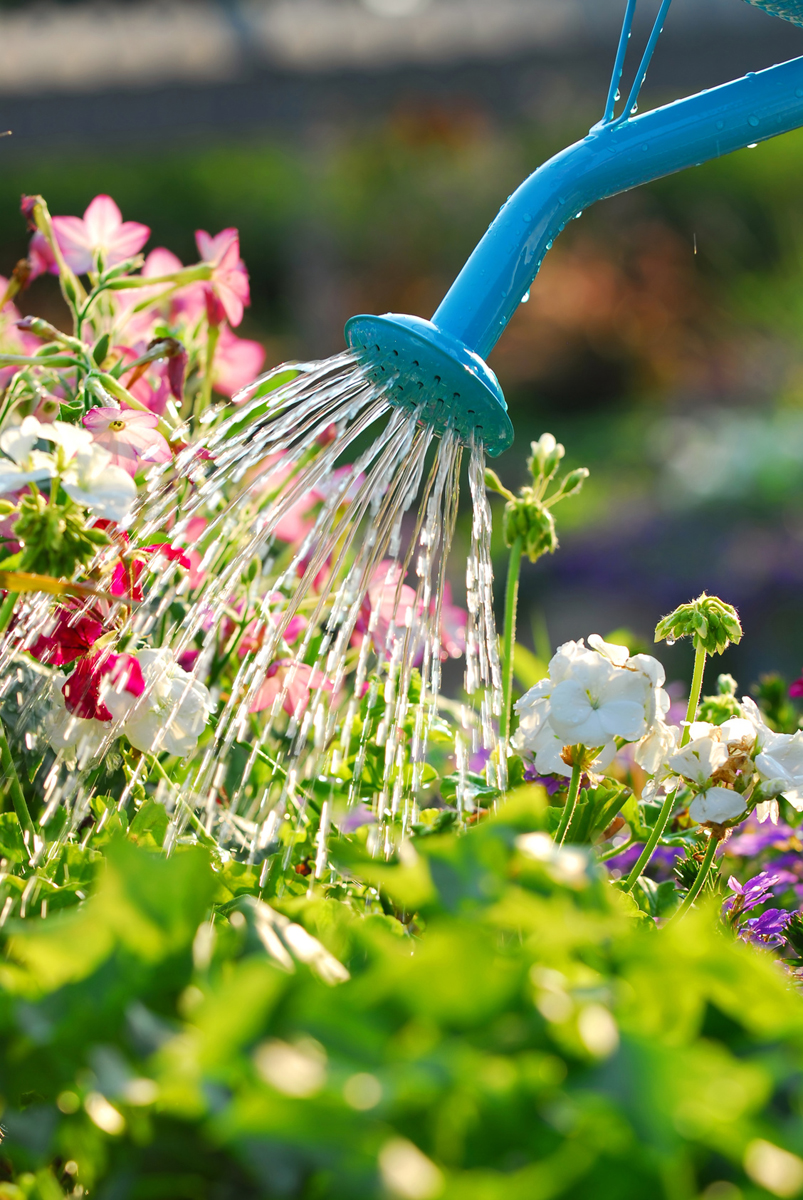Call Landscape Gal Now: (612) 366-3477
Watering

![]() Proper watering is the key for successful establishment of newly sodded lawns. New sod has an established top growth but the roots are not yet deep into the soil and as a result are extremely vulnerable to heat and drought stress. The goal is consistent even moisture assuring that the grass blades and the soil below doesn’t get too hot or too dry. Allowing the sod to dry out even once can result in failure or significant losses. Watering during establishment can mean the difference between a lush thick green carpet of grass or thin patchy grass with dead brown spots. You should expect to keep the sod moist for at least 4 weeks after installation.
Proper watering is the key for successful establishment of newly sodded lawns. New sod has an established top growth but the roots are not yet deep into the soil and as a result are extremely vulnerable to heat and drought stress. The goal is consistent even moisture assuring that the grass blades and the soil below doesn’t get too hot or too dry. Allowing the sod to dry out even once can result in failure or significant losses. Watering during establishment can mean the difference between a lush thick green carpet of grass or thin patchy grass with dead brown spots. You should expect to keep the sod moist for at least 4 weeks after installation.
The general guidelines are as follows:
- The first application of water is the most crucial and is the deepest watering. You must thoroughly soak the new sod and wet the surface of the soil below for good contact and to eliminate air pockets which can kill roots. To test if you have applied enough water, flip a roll over and look at the root mass peaty part of the sod. It should be wet not only along the seams but also all throughout the middle of the roll of sod. Remember not to overdo it and saturate the soil below as you will want to be able to walk on it. After this application, the rest are designed to maintain the moisture bond between the soil and the grass roots.
- Apply water at least twice daily, make a third application if weather is hot dry or windy or if your soil is sandy and well drained.
- Water in the morning before 9 am so as to avoid the hottest part of the day.
- Water a second time early to mid afternoon, roughly 1-2 pm.
- Water every 4-6 hours if your soil is sandy, or if the grass blades wilt between watering due to very warm temperatures or wind.
Keep in mind that sunny areas and slopes will dry out more quickly than shaded areas. Areas near pavement or with reflective heat from buildings will also dry out more quickly. Learn to identify the pale green color and thin tightly curled blades that signify wilting sod before it kills an area. If an area does wilt or slightly brown, water that area a bit extra and generally the sod will come back in a week to 10 days, but not if it has dried out too much.
The object is to keep the surface moist but not saturate the soil below. Allowing the soil to become saturated leads to fungal diseases that will kill the new sod and it will also make it difficult for you to walk out to change hoses and sprinklers without causing deep ruts from foot traffic.
As the new sod’s roots start to grow and enter the soil below, gradually cut back the frequency of the water application while increasing the amount of water applied for a deeper watering to encourage deep root growth. The goal is to eventually apply enough water once per week in one application to wet the soil 6-8 inches deep. This will be the long term watering care for your established lawn.
Long term care
![]() Mowing- once the grass has rooted down to the soil below firmly, mow it to a height of 3 inches. Test by trying to gently pull up the edges of the sod in several spots throughout the yard. If you cannot, it is safe to mow. If it pulls up, wait until it is firmly rooted or it will get sucked up and chopped in the mower. This is generally at about 3-4 weeks of age.
Mowing- once the grass has rooted down to the soil below firmly, mow it to a height of 3 inches. Test by trying to gently pull up the edges of the sod in several spots throughout the yard. If you cannot, it is safe to mow. If it pulls up, wait until it is firmly rooted or it will get sucked up and chopped in the mower. This is generally at about 3-4 weeks of age.
![]() Weeds- some weeds will inevitably come up in the seams of the new sod and this is normal. They can be hand pulled while the new sod is getting established. Herbicides should not be used until the grass has been mowed at least twice.
Weeds- some weeds will inevitably come up in the seams of the new sod and this is normal. They can be hand pulled while the new sod is getting established. Herbicides should not be used until the grass has been mowed at least twice.
![]() Fertilization- sod is growing quickly and requires fertilization. Apply a lawn starter fertilizer and follow the directions carefully. Typically this is a gentle fertilizer and will last generally a month. Read the label and it should tell you. Once enough time has passed, apply a general lawn fertilizer meant for established lawns.
Fertilization- sod is growing quickly and requires fertilization. Apply a lawn starter fertilizer and follow the directions carefully. Typically this is a gentle fertilizer and will last generally a month. Read the label and it should tell you. Once enough time has passed, apply a general lawn fertilizer meant for established lawns.
![]() Thinning- sometimes in very shady areas, sod will thin over the course of time. You may add more seed to thin areas to thicken the grass there. If an area is very shaded, turf grasses may never thrive and in those cases, we suggest ground covers other than grass.
Thinning- sometimes in very shady areas, sod will thin over the course of time. You may add more seed to thin areas to thicken the grass there. If an area is very shaded, turf grasses may never thrive and in those cases, we suggest ground covers other than grass.
